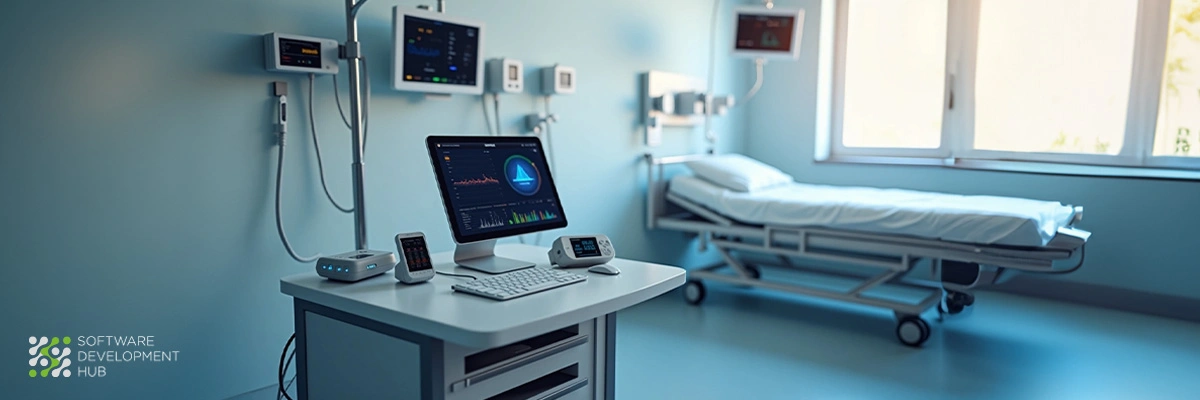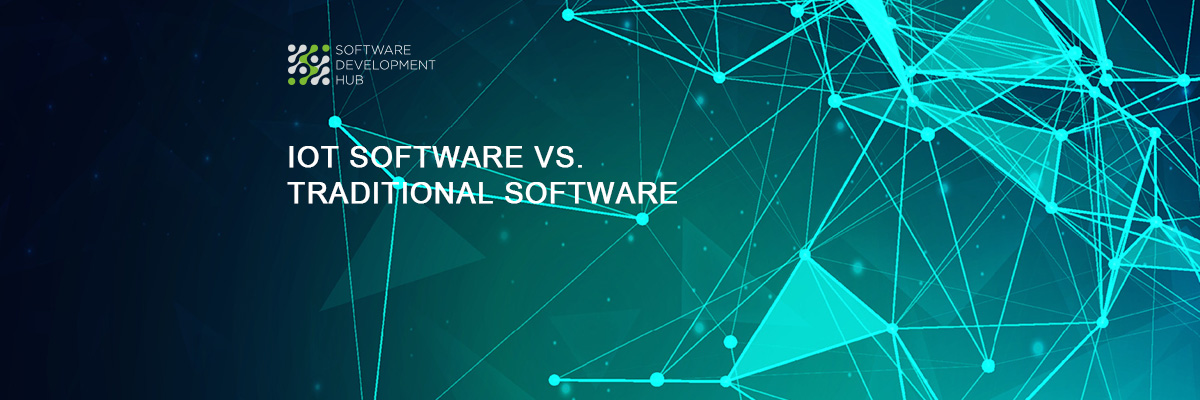IoT in Healthcare: Software Development Considerations for Medical Devices
The IoT healthcare market continues its expansion trajectory toward $534.3 billion by 2025, positioning medtech software development as a priority area for healthcare organizations. Remote monitoring devices demonstrate measurable impact on patient outcomes, reducing hospital readmission rates by 50%. Yet this growth brings substantial challenges—security vulnerabilities affect 53% of IoT devices, raising concerns about patient safety and data protection.
Medical device software development presents unique complexities that extend beyond traditional IT projects. IoT medical device design typically requires more time and resources than initial projections suggest. Battery-powered devices need specific certifications to maintain consistent performance during clinical use. Software classification becomes critical, ranging from Class A (no patient injury risk) to Class C (potential for severe harm or death).
This article examines essential considerations for medical software development, covering regulatory compliance, security protocols, and reliable IoT-enabled medical device creation. The scope includes developing reusable medical devices with single-use components and implementing risk control measures such as data encryption and multi-factor authentication. These insights will help you understand the specific requirements that distinguish healthcare IoT software development from other technology sectors.
Defining Medical Device Software in the IoT Context
Medical device software within IoT environments requires precise categorization to ensure proper regulatory compliance. These classifications directly impact development timelines, submission requirements, and market entry strategies for medtech companies.
Software as a Medical Device (SaMD) vs Software in a Medical Device (SiMD)
The International Medical Device Regulators Forum (IMDRF) establishes clear boundaries between software categories. Software as a Medical Device (SaMD) operates as "software intended to be used for one or more medical purposes that perform these purposes without being part of a hardware medical device". Software in a Medical Device (SiMD) functions as software embedded within or essential for physical medical device operations.
Independence determines the fundamental distinction: SaMD operates autonomously on general computing platforms such as smartphones or cloud systems, while SiMD requires hardware medical device integration. An insulin pump's control software represents SiMD, whereas a standalone application managing drug libraries and calculating doses qualifies as SaMD when operating independently.
Determining Intended Use and Regulatory Classification
Intended use establishes the foundation for regulatory classification decisions. The FDA employs a risk-based approach targeting software functions that meet device definitions under section 201(h) of the FD&C Act. Classification criteria include:
- The software's medical purpose (diagnosis, treatment, prevention)
- Risk level potential if software fails
- Impact on clinical decisions or patient outcomes
FDA classification divides medical device software into three risk-based categories – Class I (lowest risk), Class II, and Class III (highest risk). Class II accommodates most SaMD applications, requiring premarket notification through 510(k) submission.
Examples of IoT-Enabled Medical Software
Real-world applications illustrate these classification principles across various healthcare sectors:
- Diagnostic applications analyzing medical imaging data from X-rays, MRIs, and CT scans for abnormality identification
- Remote patient monitoring platforms enabling healthcare provider tracking of vital signs including glucose levels
- Medication management applications providing patient reminders, adherence tracking, and drug interaction alerts
- Telemedicine platforms supporting virtual consultations and remote diagnostic capabilities
Physical therapy wearables demonstrate the SaMD-SiMD boundary clearly. Device firmware operates as SiMD while companion applications visualizing patient data function as SaMD. Regulatory bodies typically require separate submissions for each component despite integrated functionality, emphasizing accurate classification importance in medical software development planning.
Regulatory and Cybersecurity Standards for IoT Medical Devices
Connected medical devices operate within a complex regulatory ecosystem where multiple frameworks intersect to ensure patient safety and data security. These overlapping standards create both challenges and opportunities for medtech software developers.
FDA Section 524B: Cybersecurity in Premarket Submissions
The December 2022 implementation of Section 524B fundamentally changed premarket submission requirements for "cyber devices." Any device with internet connectivity capabilities now requires specific cybersecurity documentation addressing vulnerability threats. Manufacturers must demonstrate three core elements: a vulnerability monitoring plan, cybersecurity processes throughout the device lifecycle, and a comprehensive software bill of materials (SBOM) documenting all components.
IEC 81001-5-1 and UL 2900 Series for Medical IoT
Healthcare software security demands specialized standards beyond general IT frameworks. IEC 81001-5-1 addresses the unique requirements of health software lifecycles, establishing protocols for confidentiality, integrity, and availability of medical data. The FDA-recognized UL 2900 series provides complementary testing criteria for network-connected devices. UL 2900-2-1 specifically targets healthcare systems, evaluating software vulnerabilities, malware resistance, and penetration testing protocols.
HIPAA and HITECH Compliance for Connected Devices
Connected medical devices must navigate established healthcare privacy regulations. HIPAA and HITECH Act requirements extend beyond traditional healthcare providers to include device manufacturers who handle protected health information (PHI). Administrative, physical, and technical safeguards become mandatory for electronic PHI protection. Device manufacturers often qualify as Business Associates under HIPAA when they create, receive, maintain, or transmit PHI on behalf of covered entities.
ISO 13485:2016 and QMS Integration
Quality management systems in medical device development require specialized approaches. ISO 13485:2016 differs from general quality standards by emphasizing regulatory compliance, risk management, and validation processes specific to medical devices. The standard mandates comprehensive documentation and record-keeping to demonstrate safety and quality throughout the entire product lifecycle.
NIST Cybersecurity Framework 2.0 Alignment
Healthcare organizations benefit from structured cybersecurity approaches that address both data protection and device integrity. The NIST Cybersecurity Framework's core functions—Identify, Protect, Detect, Respond, Recover, and the newly added Govern—provide systematic security lifecycle management. This framework proves particularly valuable for healthcare settings where cyber-physical systems like connected medical devices require protection of both patient data and physical device functionality.
Software Development Lifecycle for Medical IoT Devices
Medical IoT device software development follows a structured lifecycle that differs significantly from traditional software projects. The healthcare environment demands rigorous processes that address both regulatory requirements and patient safety considerations throughout each development phase.
Planning and Requirements Gathering for Regulated Environments
Software development planning in healthcare requires comprehensive documentation that serves as both a project roadmap and regulatory compliance tool. The development plan must account for synchronized hardware-software integration timelines, since these components often develop at different speeds. Risk control measures identified during initial risk analysis become mandatory requirements rather than optional features.
We should recognize that healthcare software requirements are typically more stable than those in other industries, yet they require extensive validation and traceability documentation. Requirements must clearly define medical purposes, intended user groups, and clinical environments where the software will operate.
Architecture and Design with Security-by-Design Principles
Architecture design for medical devices maps functional requirements into technical structures that prioritize both performance and safety. Security-by-Design principles become fundamental rather than supplementary considerations, requiring protection mechanisms against cyber threats from the initial design phase. This means products are built to protect against malicious cyber actors gaining access to devices and connected infrastructure.
The architecture must identify all software components that will undergo risk analysis, establish data flow patterns between connected systems, and define interfaces with existing healthcare infrastructure. High-level diagrams should illustrate software-hardware interactions and integration points with hospital networks or cloud services.
Testing and Verification: EMI, RF, and Network Compatibility
Medical device testing extends beyond functional verification to include electromagnetic compatibility (EMC) validation. Healthcare environments contain numerous electronic systems that can interfere with device operation, making EMC testing critical for patient safety. Essential tests include:
- Radiated emissions and immunity testing
- Electrostatic discharge (ESD) immunity
- Conducted disturbances immunity
Studies have documented RFID interference with critical medical equipment in 24% of experiments at distances up to 51 cm. This data underscores why electromagnetic interference (EMI) testing cannot be overlooked in medical device certification.
Release and Post-Market Surveillance Requirements
Post-market surveillance creates feedback loops between real-world device performance and development teams. Healthcare organizations must establish systematic processes for collecting user reports, monitoring device performance metrics, and identifying emerging safety concerns. This surveillance often reveals usage patterns and potential issues that clinical testing cannot fully anticipate.
Real-world data collection provides insights into device performance across diverse healthcare settings, patient populations, and clinical workflows that laboratory testing cannot replicate.
Managing Software Updates and Recertification
Software maintenance in healthcare requires careful balance between innovation and stability. Most software patches don't require prior FDA approval, yet internal validation processes must maintain the same rigor as initial certification. Update protocols must ensure changes don't compromise device safety or introduce new risks to patient care.
Annual recertification processes may apply to certain device categories, with failure to complete requirements potentially resulting in user access revocation and reapplication mandates. Change management becomes particularly critical when updates affect core medical functions or safety-related features.
Conclusion
Healthcare IoT integration presents both substantial opportunities and critical responsibilities. Medical device software development requires careful attention to regulatory frameworks, security protocols, and risk management strategies. Proper classification of software components as SaMD or SiMD establishes the foundation for compliance success, while adherence to standards like FDA Section 524B, IEC 81001-5-1, and HIPAA protects both patient safety and data integrity.
Security vulnerabilities affect over half of IoT devices currently, making security-by-design principles essential rather than optional. Pre-certified components, automated compliance documentation, and continuous monitoring offer practical solutions that address these challenges while shortening development timelines. Software development lifecycles designed specifically for medical devices help maintain the balance between innovation and regulatory compliance.
Risk management should guide every development phase. Risk-based supplier management, thorough testing protocols, and effective post-market surveillance work together to create comprehensive safety systems around connected medical devices. While IoT medical device development involves more complexity than standard software projects, the patient care benefits justify these additional requirements.
Medical IoT operates where technological innovation meets patient safety. Success depends on combining technical expertise with solid regulatory knowledge. Companies that follow these principles will create safer, more effective medical devices while managing the complex medtech environment with confidence.
Categories
Share
Need a project estimate?
Drop us a line, and we provide you with a qualified consultation.








